Ross Douthat recently published three articles about chronic illness:
Douthat struggled with chronic Lyme Disease for more than five years. The subject of chronic illness has acquired a new urgency since Covid sometimes becomes chronic. Chronic illness raises baffling questions: What illness do I have? If I have, say, Lyme Disease or Covid, how should it be treated? Can I rely on Establishment expertise, or should I turn to alternative treatments, outsider treatments? Could this illness be a function of my state of mind?
When my late wife was diagnosed with cancer, it quickly became clear to me that the medical world is divided between Establishment Medicine and Alternative Medicine. People often question Establishment Medicine because it has little to offer those suffering from advanced cancer or chronic illness. The advice of conventional doctors often contradicts other conventional doctors, and often contradicts the patient’s experience.
Once you start to doubt Establishment Medicine, once you become receptive to Alternative treatments, then you begin to wonder if truth has any boundaries, if there are any solid truths on any subject. You’re like a person who once believed that the Earth is solid, then experienced an earthquake in which the surface of the earth felt like it was wobbling on liquid.
Douthat writes, “I am more open-minded about the universe than I was seven years ago, and much more skeptical about anything that claims the mantle of consensus.” Doubts about the Establishment have implications for politics. Douthat says, “The conspicuous elite failures in the last 20 years have driven many voters to outsider narratives, which blend plausible critiques of the system with outlandish paranoia.” Douthat calls for a middle position:
| What we need, I’m convinced, are more people and institutions that sustain a position somewhere in between. We need a worldview that recognizes that our establishment fails in all kinds of ways, that there’s a wider range of experiences than what fits within the current academic-bureaucratic lines... and yet at the same time still accepts the core achievements of modern science, [and] treats populist information sources at least as skeptically as it treats establishment sources. |
I’m more skeptical than Douthat about the “core achievements of modern science.” For many years, Newton’s picture of the universe seemed rock-solid, a “core achievement,” but it was upended by Einstein. Einstein’s universe was challenged by quantum physics; Einstein never made his peace with quantum physics, and the scientific community as a whole hasn’t made sense of quantum physics.1 As for Darwin’s achievements, they raise as many questions as they answer, as I argued in an earlier issue.
Is Douthat naive to speak of “accepting” the “core achievements” of modern science? Modern science can’t be “accepted” as long as it ignores the vast field of the occult, which impinges on many other fields. It’s impossible to distinguish between science’s core achievements and its peripheral achievements, just as it’s impossible to distinguish between fake news and real news.2
A. I recommend a BBC podcast called In Our Time. It has been broadcast weekly for more than 20 years; there are now more than 900 episodes on their website. It deals with historical topics (such as William Cecil), scientific topics (such as the evolution of horses), literary topics (such as The Great Gatsby), etc. If you see a message “Not available outside the UK,” look for the podcast on Youtube. (I think it’s a scandal that the BBC and PBS don’t make their content freely, universally, and permanently available. What’s the point of creating new content if you don’t make your existing content available?)
B. Nomadland (2020) is a great movie, a “neo-Western” about people taking to the road in campers, living a nomadic life. Most of the nomads are older people, who have lost spouses or children.
In the last issue, I discussed frevel, and then I received an e-mail from Elliott Banfield, who said that frevel reminded him of what C. S. Lewis called “flippancy.” In his book The Screwtape Letters, Lewis used the word “flippant” to describe an attitude of cool sophistication, irony. Lewis wrote,
| Among flippant people... every serious subject is discussed in a manner which implies that they have already found a ridiculous side to it.... The joke is always assumed to have been made. No one actually makes it. [Flippancy] is a thousand miles away from joy: it deadens, instead of sharpening, the intellect; and it excites no affection between those who practice it. |
Fashionable people are often flippant rather than serious because seriousness can result in ridicule, and one must avoid ridicule at all costs. Proust depicted a character named Swann who moved in fashionable circles. Proust said that Swann avoided
| saying in all seriousness what he thought about things.... Whenever he spoke of serious matters, whenever he used an expression which seemed to imply a definite opinion upon some important subject, he would take care to isolate, to sterilize it by using a special intonation, mechanical and ironic. |
Flippancy, irony, sophistication — all are social attitudes, whereas frevel can exist in solitude, frevel can exist when the individual is alone with the universe. Another characteristic of frevel is that it teases, it challenges, it dares. Marie-Louise von Franz, a disciple of Jung who introduced me to the concept of frevel, says that frevel is “infantile daring,” it looks like courage but it isn’t. A zookeeper who tries to entertain people by putting a hat on a grizzly bear, and then gets attacked by the bear — this would be frevel.
Von Franz tells a story, a “mountain saga,” about a Swiss herdsman. According to custom, the herdsman should
| go out in the evening and recite the benediction over the cattle and the Alp in the four directions of the horizon. One evening the herdsman came out of the hut and a voice up in the mountains called out, “Shall I let it go?” And he, instead of getting frightened, said “Oh, you can hold it still longer!” And nothing happened. The next day passed, and the next evening the voice said, “Shall I let it go?” The herdsman called out, “Oh, you can hold it longer!” Then he suddenly heard a cry from the top of the mountain, “I can’t hold it any longer!” And with an awful roar the whole mountain collapsed, burying cattle and huts and herdsman.3 |
The herdsman didn’t respect the “numinous powers,” he “talked back,” he had “infantile daring,” he was “looking for trouble,” he was “asking for it.”4
Proust’s character, Swann, is also “looking for trouble.” When Swann is 30 or 35, he resolves to live solely for love, like the people in novels. Proust says that Swann is at a “dangerous age.” Swann is being reckless, like the herdsman, and Swann becomes mired in an emotional morass. Proust shows us the difference between irony/flippancy and frevel: irony is a social attitude, a style of conversation, an attitude of cool sophistication, whereas frevel can be solitary (Swann resolves, in silence and solitude, to live only for love).
In an earlier issue, I discussed Philippe Petit, who became famous for walking on a tight-rope stretched between Manhattan’s Twin Towers:
| [Petit] said it was easy being on the wire, and he felt happy there. Finally he decided to get off; he said he didn’t want to tempt fate, didn’t want to annoy the gods that are in the buildings, in the wire, in everything.... Petit was successful because he wasn’t a freveler, he knew when to stop. |

Philippe Petit, August 7, 1974
Petit had the audacity to walk between the Towers, and the humility to stop walking. He respected the “numinous powers,” he had a cosmic piety. This piety is a matter between the individual and the universe, it’s not a social attitude, like flippancy, irony, and sophistication.
The case of Petit shows that people who believe in some sort of gods, people who believe that the universe is alive, are less likely to commit frevel. People who believe in a spiritual dimension, who are receptive to the occult, are more likely to feel a cosmic piety, and a sense of kinship with the universe. Insofar as modern man subscribes to atheism/materialism, he’s prone to frevel and impiety, he’s prone to believe that the universe is mostly dead matter, with which he has no bond, no rapport.
I discussed frevel in several earlier issues:
| 2004-9b |
|
| 2008-5c | frevel and Hemingway’s The Old Man and the Sea |
| 2010-7 | frevel in Thomas Hardy’s Far from the Madding Crowd |
| 2012-9 | how Philippe Petit exhibited the opposite of frevel |
| 2013-10b | frevel in Poe’s “The Black Cat” |
| 2017-12 | frevel and Werner Herzog’s film Happy People |
| 2018-1 | frevel in my own experience |
| 2021-02 | frevel and Werner Herzog’s film Fitzcarraldo |
| 2021-9 | frevel in Henry James’ “Daisy Miller” |
| 2021-10 | frevel in Henry James’ “Aspern Papers” |
| 2021-10b | frevel and piety |
| CWGT | frevel in “Squirrel Nutkin” and in Proust’s Swann’s Way (for more on frevel in Swann’s Way, click here) |
There are two ways to understand frevel: by looking at examples of frevel (such as Squirrel Nutkin), or by looking at examples of the opposite of frevel (such as The Old Man and the Sea). In many cases, the opposite of something reveals as much about it as the positive form.
Primitive man often used the same word for a thing and its opposite. Freud wrote an essay called “The Antithetical Sense of Primal Words” (1910), in which he noted that the Latin word sacer meant both accursed and blessed, and the Latin word altus meant both high and deep. Freud said that dream language uses words in both their positive and negative senses; he wrote, “Dreams show a special tendency to reduce two opposites to a unity or to represent them as one thing.” A dream about frevel could have a case of frevel or a case of the opposite of frevel.
Should we use the word frevel for both frevel and its opposite? Or should we speak of frevel and un-frevel (or anti-frevel)? Or should we reverse the word frevel to signify a reversal of meaning, as some languages do with some words? Reversing frevel gives us “leverf.”
As I discussed frevel in earlier issues, so too I discussed irony in earlier issues:
| 2004-8 | how a modern critic finds irony in E. M. Forster when (in my view) there is no irony; how modern critics see irony everywhere; how modern critics project their own irony onto the classics |
| 2006-10 | irony with respect to the work of Alain de Botton, Elie Kedourie, and Proust |
| 2009-4b | irony/lack-of-conviction in New Yorker magazine |
| 2009-6 | Dickens on the irony/sophistication/lack-of-enthusiasm of James Harthouse, a character in Hard Times |
| 2013-4 | how the irony of Socrates is based on “ethical passion,” and the irony of Jane Austen is based on “essential moral interest”; is there a “good irony” as well as a “bad irony”? |
| 2014-11b | irony and a “smirking tone” in the movie Grand Budapest Hotel |
| 2015-9 | irony in modern culture; Susan Sontag’s essay “Notes on ‘Camp’” says that, beginning in the early 1960s, everything is viewed with irreverence and ironic detachment, the artist “sees everything in quotation marks” and “converts the serious into the frivolous”5 |
| 2021-3 | Dickens on the irony/boredom/indifference of Jack Maldon, a character in David Copperfield |
I think everyone would agree that irony isn’t always a bad thing. Kierkegaard seems to have distinguished between “good irony” and “bad irony” in his Concept of Irony. Doubtless Kierkegaard would approve of irony that’s used to satirize vice or folly, doubtless he approved of Socrates’ irony. He probably wouldn’t approve of irony that’s directed at life in general, irony that expresses a superior or sophisticated attitude.
I recently visited “solstice stones” in Boxborough, Massachusetts. The stones were arranged by Indians to catch the sun’s rays at the winter solstice. A flat rock was placed on the other side of the field, as a viewing platform. No one knows when this arrangement was made; I would guess it was made before Columbus.
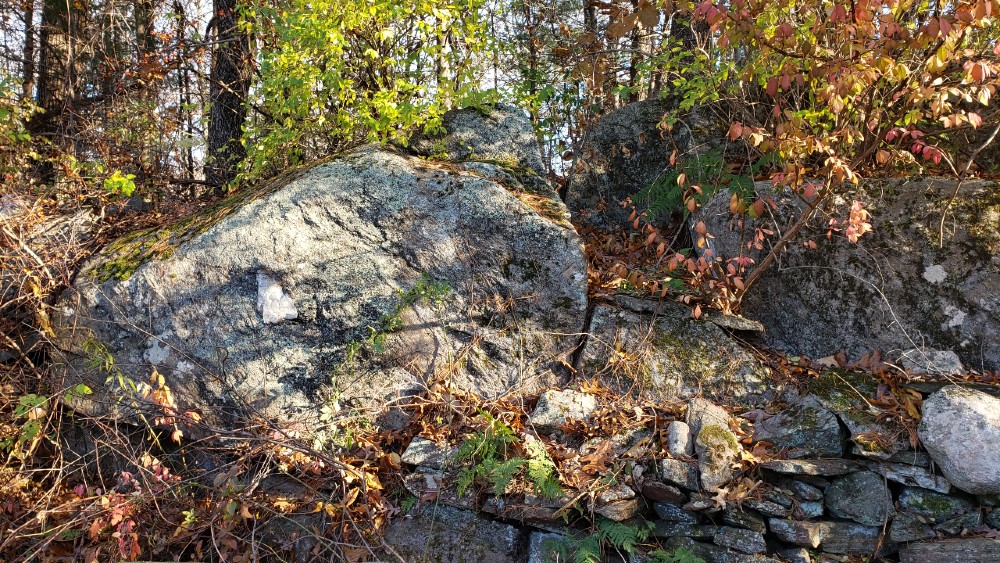
Note the chunk of quartz in the main boulder. This quartz makes the boulder look like a massive piece of jewelry. Indians had a special regard for quartz. The dark horizontal lines on the main boulder are shadows. Below is the same image with a red circle around the chunk of quartz, and a red V on the aperture through which the sun comes at the solstice.
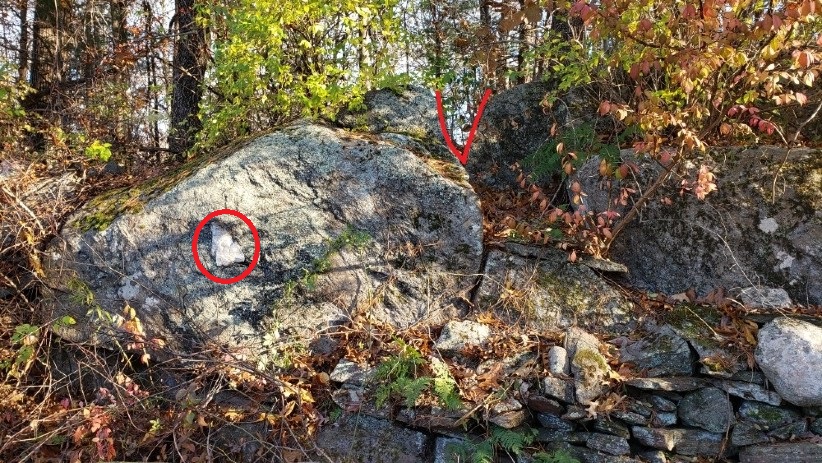
In the last century or two, the structure was neglected, forgotten, overgrown. About thirty years ago, a Boxborough resident named Byron Dix discovered the structure, then demonstrated its significance at the winter solstice. Dix co-wrote (with James Mavor) a book called Manitou: The Sacred Landscape of New England’s Native Civilization.
Dix and Mavor dedicate their book to Alexander Thom, who researched prehistoric stone structures in Great Britain and Brittany. Dix and Mavor call Thom a pioneer of “archaeo-astronomy.” They visited Thom in 1978. Like Dix and Mavor, Thom encountered resistance from the archeology establishment.
Before Dix made his discovery in Boxborough, many people must have thought that the Boxborough stones were natural, not modified by man in any way. The Indians often made structures that modify nature in a subtle way. The boulders haven’t been cut or shaped.
Are the Boxborough stones science, art, or religion? They seem to be a combination of all three. They suggest a society in harmony with nature. The structure might be called a humble work, since it doesn’t call attention to the cleverness or skill of the makers. The makers are turning our attention to nature, not turning our attention to themselves.
Perhaps all early societies performed rituals, and built structures, that combine science, art, and religion. Only in relatively recent times have science, art, and religion been separated. An early poem, for example, wasn’t pure art, it dealt with the cosmos in a quasi-scientific, quasi-religious way.
The Boxborough stones weren’t arranged with precision, the builders weren’t trying to display their mastery of astronomy. The V-shaped opening is large enough to catch the sun’s rays several days before, and several days after, the solstice.
One might say that the stones lack “pinhole precision,” but they have “general precision.” They catch the solstice sunrise perfectly, and the V is perfect. The stones haven’t moved, haven’t “settled,” since they were set up. So the Indians must have given the stones a solid foundation, a foundation that ensured the stones would “stay put.”
[Update December 2021
I visited the site on December 20, one day before the solstice. It’s a memorable experience, a real “sunburst.” Somehow the V-shaped aperture concentrates the sun’s rays, creating a spectacular burst of light. The sunburst occurs at 7:30; by that time, there’s considerable ambient light, so you’re not walking around in darkness. Look for a day without clouds, even if it isn’t December 21. The Native Americans evidently spent much time arranging the site, positioning the stones.]
The main boulder probably weighs more than 5,000 pounds. How was it moved without wheels or horses or cows? If a boulder with the right shape, and with a chunk of quartz, is rare, it might have been moved a mile or more, and it might have been moved uphill.
Dix and Mavor, the authors of Manitou, have both died. George Krusen now leads occasional tours of the site.5B
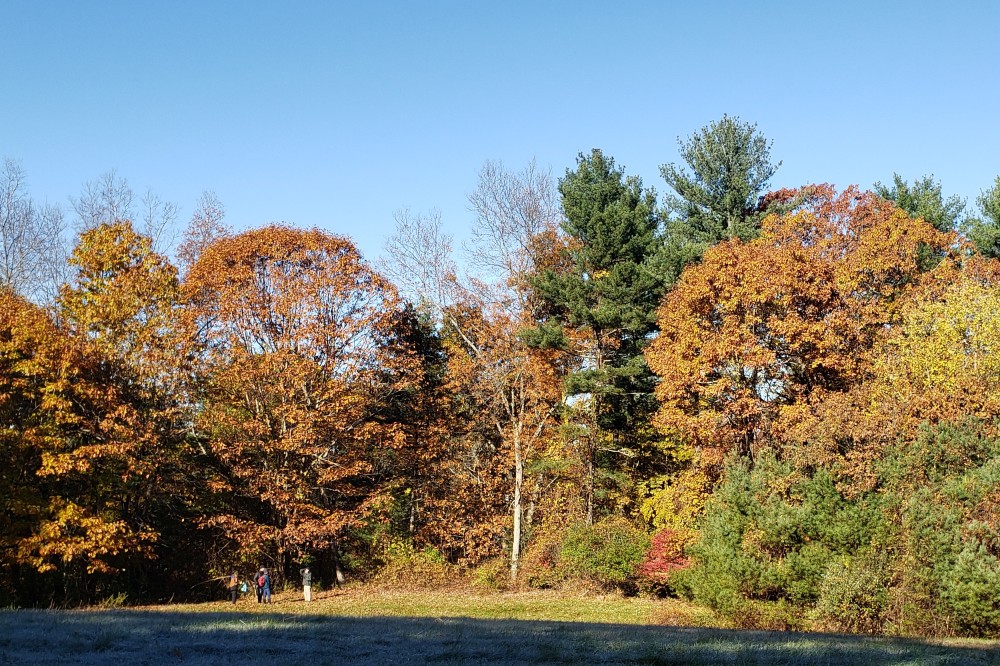
George Krusen finishing a talk on Indian stonework
The site is now owned by the Sudbury Valley Trustees. Below is a map of the site.
On the map above, I’ve marked the V-shaped aperture with an A, and I’ve marked the viewing platform with a P. You’ll notice that the aperture (the sunrise) isn’t directly east of the viewer (the platform), as it would be at the equinox. The aperture is southeast of the viewer (A is southeast of P).
Below is a picture of the viewing platform.
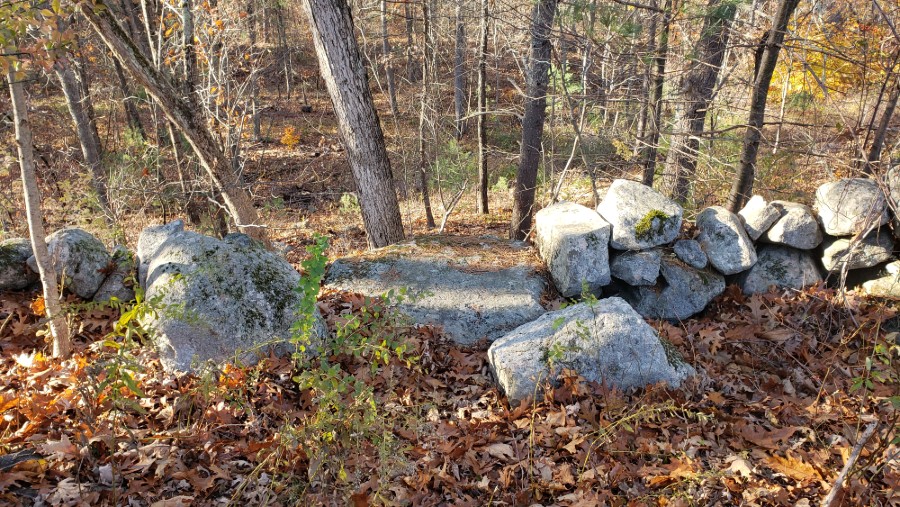
There are two large boulders flanking the “platform stone,” calling attention to it; this seems to be characteristic of StoneRow viewing platforms. In the picture below, I’ve marked the flanking boulders F, and the platform stone P.
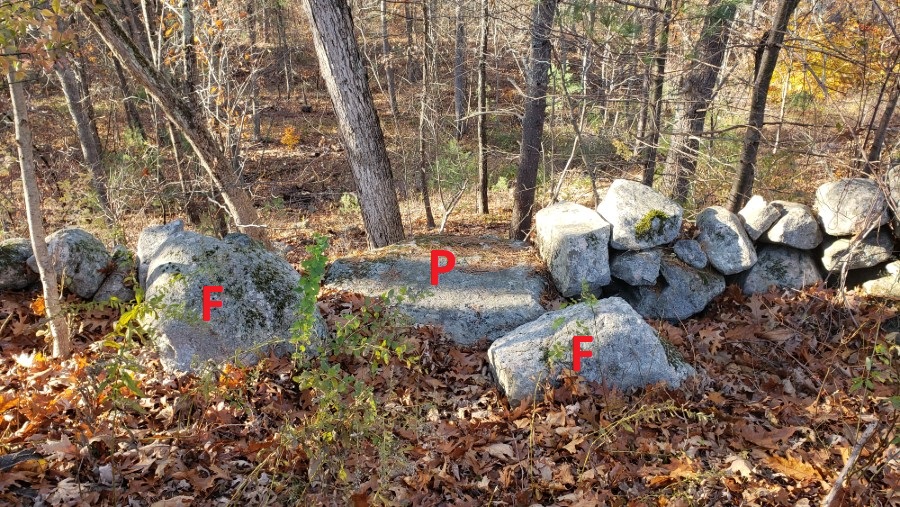
In the nearby town of Acton is another Indian site. This site is on the Nashoba Brook Conservation Land. Indian sacred spaces are often near water, or on a high place, or in a swamp. While the Boxborough stones are just a spot, not a trail, the NashobaBrook stones are on a charming, well-marked trail, with a mill-pond and the remains of colonial houses and mills. Below is a 3-mile route through the NashobaBrook site.
The NashobaBrook site includes a stone chamber that was built into a small hill. Some people say that an aperture in the chamber admits a beam of morning sunlight, which hits a quartz rock at the winter solstice; I haven’t been able to confirm this report, I didn’t find any quartz in the chamber.6 The ceiling is made of massive, flat slabs that don’t appear to have been cut or modified; the slabs are skillfully arranged so the chamber stays dry.7 Early settlers probably used the chamber for shelter, and for food-storage, but I believe it was built by Indians, perhaps as a place to observe the solstice, perhaps as a place to await visions, or to have some sort of spiritual experience.
The picture below was taken at the NashobaBrook site. It appears to be an ordinary stone wall, not unlike countless other stone walls built by colonists in New England. On closer inspection, however, it appears to be an Indian structure. To distinguish it from stone walls, it’s called a “stone row.”
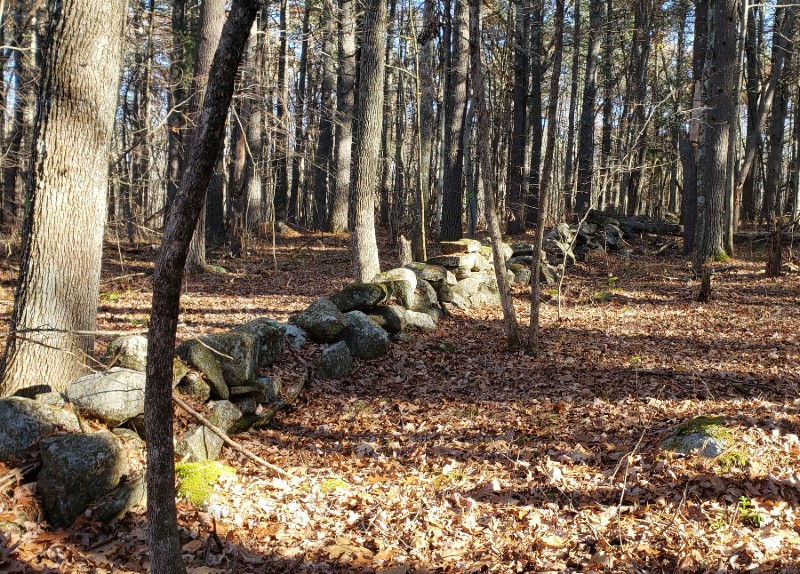
At its western end, it has a terminus characteristic of stone rows:
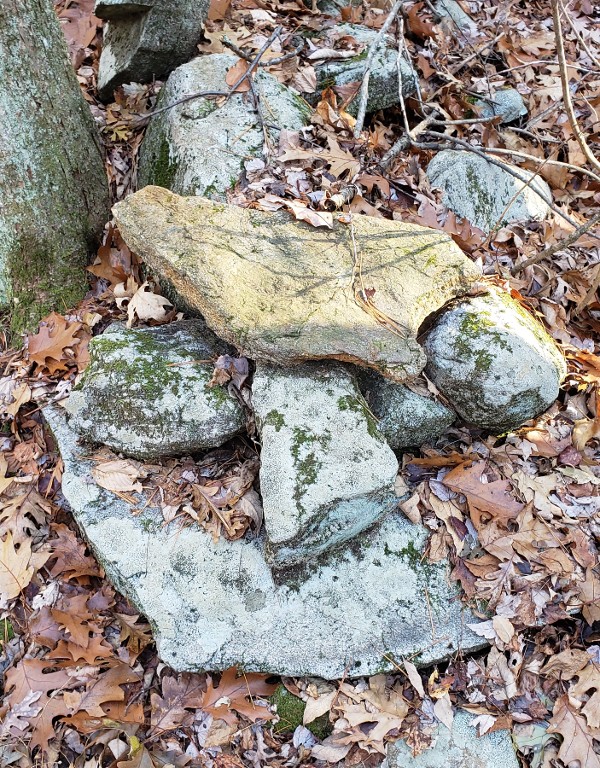
I’ve seen a lot of stone walls built by white settlers, but I never saw anything like this. Note the top stone in the “terminus arrangement.” It has the head-and-shoulders shape of a “Manitou Stone.” Below is a Manitou Stone from a site in North Salem, New Hampshire.
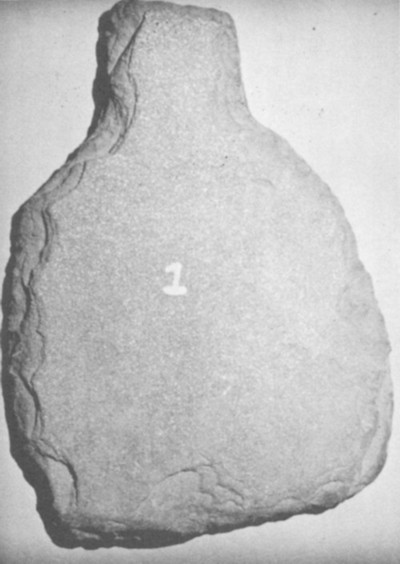
Dix and Mavor say that Manitou Stones are sometimes found in stone rows. Manitou Stones are found not only in New England, but throughout North America. Colonists called them “god-stones.” The word “Manitou” means spirit, energy, life force, divinity.8
The stone row is part of a three-sided enclosure, as if the Indians wanted to demarcate a sacred area, but not completely enclose it. There seems to be a similar stone enclosure at the Boxborough site.
We know that colonists had practical reasons to build stone walls; they wanted to confine farm animals, demarcate property, and rid their fields of rocks. The stone rows built by Indians had no practical purpose. Like the solstice stones in Boxborough, stone rows were a blend of science, religion, and art.
Within the enclosure at the NashobaBrook site are numerous stone piles. Stone piles were “often created by Native Americans to memorialize an important event, death, or person.”10 Some stone piles were made on the ground, others on erratic boulders. Below is a typical stone pile.
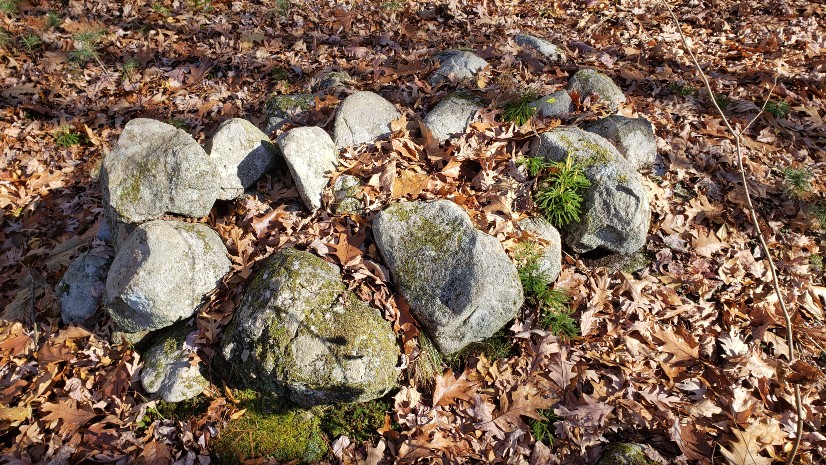
“How do you know this was made by Indians? Couldn’t it have been made by colonists?” Colonists wouldn’t make ten small piles, they’d make one large pile. Colonists made stone piles to free their planting-area of stones, but here there’s no attempt to create a stone-free area. Furthermore, these piles are within an enclosure, along with other ritual structures.
In addition to making stone piles, Indians made stone effigies — arrangements of stones that resemble turtles, snakes, etc.
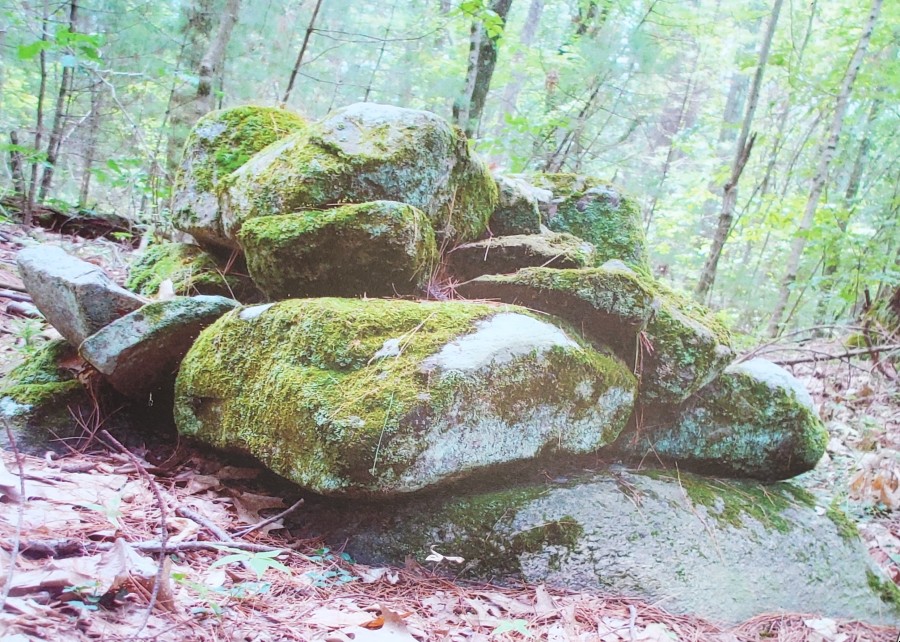
Turtle effigy, NashobaBrook site
A snake effigy in nearby Carlisle extends some 300 yards.

Head of Carlisle snake

Tail of Carlisle snake
Below is another picture of the head of the Carlisle snake. Note the chunk of quartz at the left eye (the snake’s right eye).
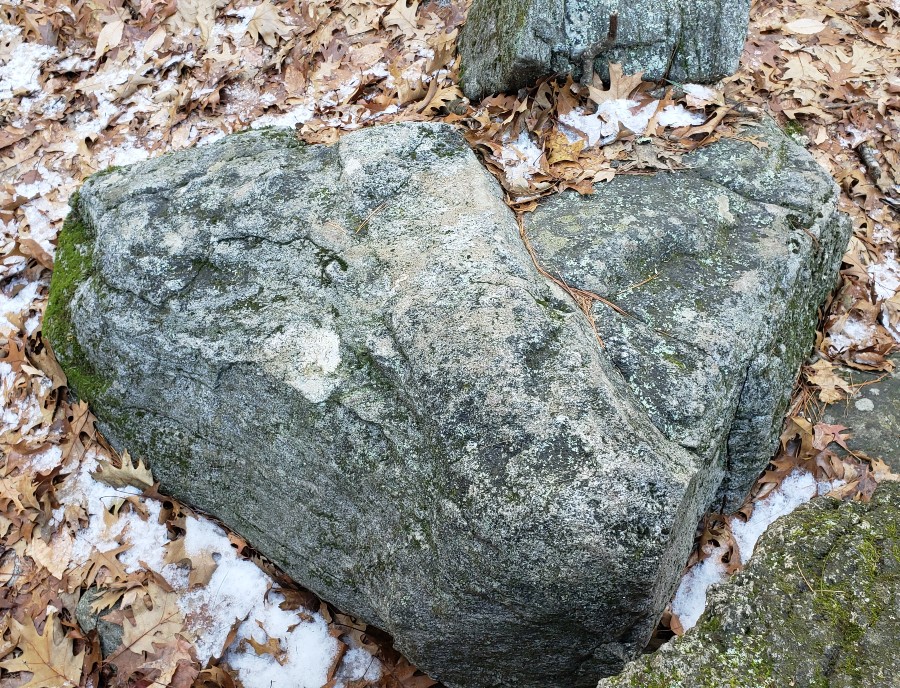
Here’s the same picture with a circle around the “quartz eye.” (It may appear to be lichen, not quartz, but when you inspect it closely, I think you’ll find that it’s quartz.)
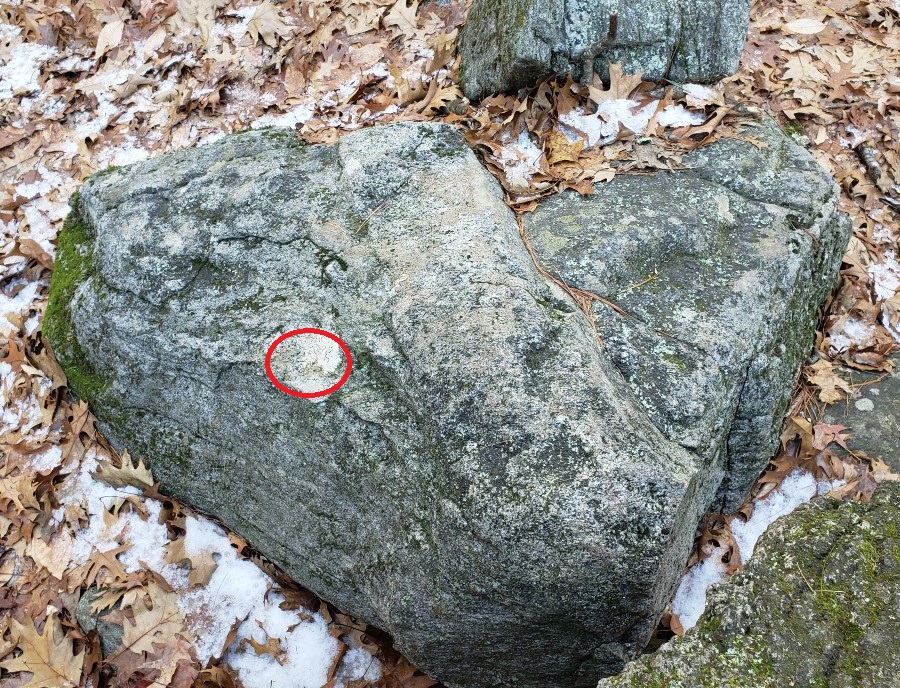
Was this head chipped or cut or shaped? Or is it completely natural? I’m inclined to believe that it’s natural, just as I believe that the Boxborough solstice stone (the stone with a chunk of quartz) is natural. Whether the snake head is cut or natural, it shows yet again that the Indians were fascinated by quartz.
For more on the Carlisle snake, see my notes on Great Brook Farm State Park.
Indians attached special significance to cleft rocks, and often placed smaller rocks in the crack. Sometimes they tried to widen a crack by pouring water into it; as the water froze and thawed, the crack would widen (water expands by about 9% when frozen, and when rocks are left to themselves, many are split by water). According to the NashobaBrook signs, there’s one cleft rock in the enclosure.10B
The trail through the “sacred area” is marked in green on the map, and marked in green on the trail itself (the best maps seem to be at the kiosks). There’s a second “sacred area,” with green markers, just southeast of the one I discussed above. The second area is called “Pipsissewa” (the first area is called “Princess Pine”). On the map below, I’ve marked the second area with an S, the first area with an F (this map shows how the Indian structures can be approached from the south, from the DavisRoad parking lot).
There’s a kiosk at the start (the northern end) of the Pipsissewa trail. At the southern end of the Pipsissewa trail, there’s a “quarry stone” — that is, a stone from which white settlers cut a block. There are various stone rows in the vicinity of Pipsissewa. One might represent a snake, though not as clearly as the one near Wolf Rock in Carlisle. Another stone row might align with the solstice sunset, though I’m not certain. There are several stone piles near the Pipsissewa trail, such as the one below:
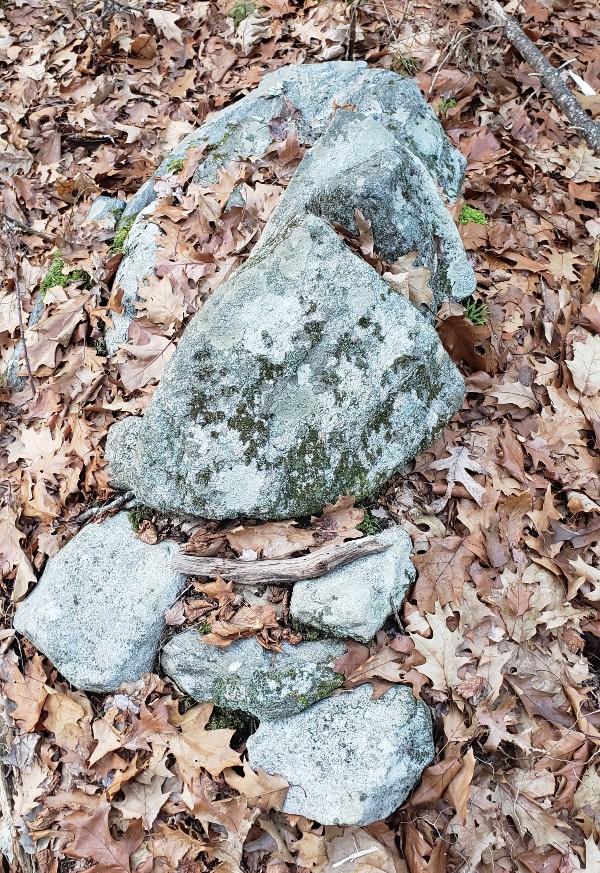
At first glance, this might seem like an ordinary pile of stones, but then you realize that the stones point in a particular way, as I show in the image below:

Whoever made this stone pile had respect for stones. This isn’t the sort of stone pile that white settlers made.
Indians admired unusual land-forms, such as eskers. One of the largest eskers in New England is in Boxborough. Dix and Mavor argue that the Boxborough esker was a sacred place for the Indians, “central to their world.”11 Eskers have flat tops, and make pleasant trails, but the Boxborough esker is noisy, it’s close to the highway (495).
Dix and Mavor mention “earthen circles,” “large stone mounds” and a stone chamber, but I didn’t find them, I didn’t find anything but stone rows. A coyote seemed to be living on the esker; when he noticed me approaching, he trotted off into the marsh. The trail is about 1.6 miles (3.3 miles round-trip). It ends abruptly when it reaches the property of the Harvard Sportsmen’s Club.
The first 40% of the above route is the approach to the esker, the last 60% is the esker itself. During the first 40%, you’ll ask yourself many times, “What am I doing here? Why did I come to this God-forsaken place?”
Dix and Mavor refer to the Acton-Boxborough region as “Nashoba.” In the 1600s, it was the seat of a tribe of “praying Indians,” Christianized Indians.
Despite the abundance of evidence from all over New England, some professional archeologists insisted that Indians were nomadic, and they didn’t build stone structures; the professionals wouldn’t admit that Dix and Mavor, mere amateurs, had made important discoveries. The blindness of specialists never ceases to amaze me.
More on Indian stones
Estabrook Woods, Concord MA
Great Brook, Carlisle MA
Beebe Woods, Falmouth MA
Maudslay State Park, Newburyport MA
Standing Stones, Smithfield RI
Queen’s Fort, Exeter RI
© L. James Hammond 2021
feedback
visit Phlit home page
become a patron via Patreon
make a donation via PayPal
| Footnotes | |
| 1. | As Bill Bryson put it, quantum physics has shown that “one particle could instantaneously influence another trillions of miles away.... No one, incidentally, has ever explained how the particles achieve this feat. Scientists have dealt with this problem, according to the physicist Yakir Aharanov, ‘by not thinking about it.’”(A Short History of Nearly Everything, Ch. 9, pp. 146, 147) back |
| 2. | In a recent issue, I discussed Douthat’s view of the occult. Douthat is a deep thinker, and he puts his finger on some important issues. back |
| 3. | Shadow and Evil in Fairytales, Ch. 11, pp. 143-144. I’ve modified the translation slightly. back |
| 4. | One might say that the herdsman lacked fear. Reverence and fear are related; the word “reverence” comes from the Latin vereor, fear. According to the Elizabethan poet Francis Quarles, “The ill that’s wisely feared is half withstood.” back |
| 5. | The phrase “irreverence and ironic detachment” comes from Michael J. Lewis back |
| 5B. | If you want a brief introduction to Indian structures, I recommend A Guide to New England Stone Structures (2006), which deals with the structures of white settlers as well as those of Indians. The authors are Mary and James Gage. The prose is third-rate, but it’s a readable pamphlet/book, and it has useful illustrations. The authors draw on the work of Dix and Mavor. The pamphlet may be hard to find. The publisher is
Powwow River Books This “publisher” is doubtless a self-publishing project. George Krusen is interested in the so-called “Hill of 500 Cairns” in Harvard. Click here for map with comments. The cairns were apparently discovered around 1930 by Dr. David MacGregor Cheney of Clinton, Massachusetts. Cheney kept the site a secret until around 1960, when construction of Route 495 threatened the site. When he publicized the site, many of the cairns were destroyed, perhaps by someone who wanted highway-work to be unimpeded (see Cheney letter, page 1 page 2). Cheney was an eccentric intellectual, who collected nuggets of information for more than 50 years, in order to make what he regarded as a new kind of encyclopedia. Around 1960, a professional archeologist, Frederick Johnson, was called in to evaluate Cheney’s cairns. Johnson was the curator of the Peabody Institute of Archaeology, which is based at Philips Academy in Andover, Massachusetts. Johnson wrote a report, dismissing the cairns as piles of rocks with no archaeological significance. (It’s not clear to me whether Johnson inspected the site before many of the cairns were destroyed.)
I don’t think Cheney would have been surprised by the blindness of the “expert.” Before Johnson visited the site, Cheney begged for the appointment of an expert with an “open mind.” Indian remains aren’t rare, but open minds are rare. back |
| 6. | An article in the Boston Globe says that the beam of light hits “a spot just below a large stone of quartz.”(Boston Globe, 7/14/1998, p. B7, obituary of Mark Strohmeyer) George Krusen told me that the beam hits a vein of quartz. Further discussion of NashobaBrook site in the Boston Globe, 1/5/1997, front page of “NorthWest Weekly.”
“Quartz is known to have played an important role in Indian ritual.” (Manitou, Ch. 7, p. 177) William Vales tells me, “Fine-grained stones such as obsidian, chert, rhyolite, quartz or quartzite were highly prized [by the Indians].” Some people track the movement of the sun on their ceiling, by placing a shiny object on a windowsill, an object that reflects the light onto the ceiling. If you notice the sun hitting the same spot on the ceiling at the same date (and the same time of day), you can mark that spot, so eventually the sun’s movement throughout the year is drawn on the ceiling.
If you have light coming from the ceiling, you don’t need to put a shiny object on the windowsill, you can track the sun’s movement on the floor. When I discussed Roman history, I mentioned a basilica that tracks the sun’s movement on its floor. back |
| 7. | Local historian Daniel Boudillion says there are eight stone chambers in the area — six in Littleton, one in Harvard, and one in Acton.
Click here for my remarks on a stone structure in Exeter, Rhode Island (Queen’s Fort). back |
| 8. | “There is a general custom amongst [the Indians], at the apprehension of any excellency in men, women, birds, beasts, fish, etc. to cry out ‘Manitou!’” (Roger Williams, quoted in Dix and Mavor, p. 2)
For more on Manitou Stones, see Dix and Mavor, Ch. 13, p. 332. If you remove the manitou stone from the terminus arrangement, you’re left with a group of three stones, a group that resembles a person’s head and shoulders; in other words, these three stones create a “manitou effect.” Just east of the “terminus arrangement” may be another arrangement never found in the walls of colonists: a viewing platform, like the Boxborough platform. The NashobaBrook platform isn’t clearly visible, and may have been disturbed by a growing tree. The kiosk has a picture of a viewing platform; the kiosk describes it as an “embrasure,” an “observation post.” But the kiosk picture doesn’t match any viewing platform in this stone row; I’m not sure where the picture was taken. Assuming there is a viewing platform at Nashoba Brook, what is it designed to view? Does the stone row align with any astronomical event? It seems to point northwest (about 40 degrees north of west). The TrailThroughTime website mentions a possible connection to the setting of the sun on August 12, a special date for many Indian tribes. The kiosk says that the stone row “aligns with the sun’s... winter solstice set.” But this must be an error. At the winter solstice, the sun sets in the southwest, but this row points northwest. The kiosk also says that the row aligns with the summer solstice sunrise (at its opposite end, its eastern end). But this sunrise would be in the northeast, while the row points southeast. Some stone rows have bulges with hundreds of stones, like a burl on a tree. Below is a “wall bulge” from Boxborough.
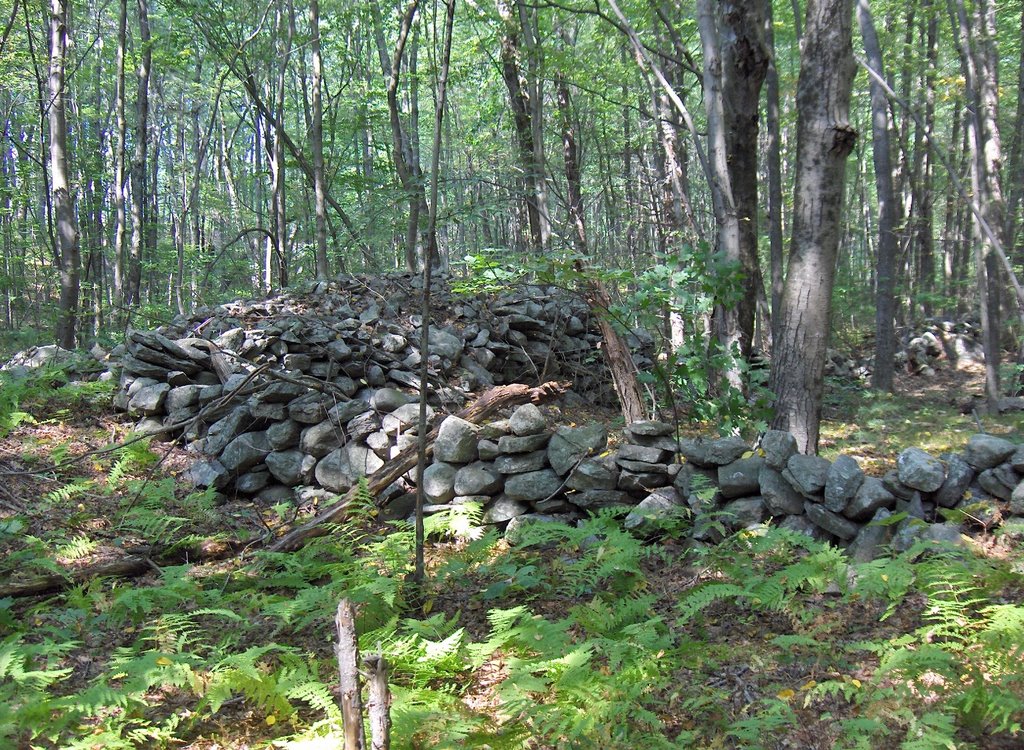 The above bulge seems to be behind the playing fields at Boxborough’s Liberty Square. |
| 9. | Footnote 9 has been deleted. |
| 10. | Web page back |
| 10B. | Below is a cleft rock from the enclosure, probably the one mentioned in the signs.
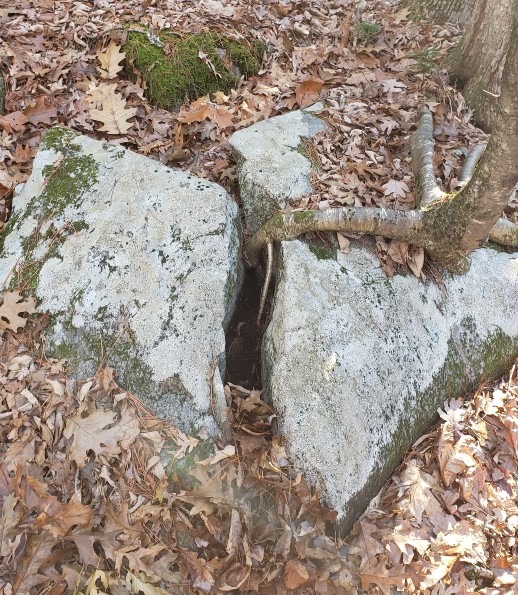
I’m not sure how we can distinguish this “sacred” cleft rock from an ordinary, natural cleft rock. There seems to be a small rock in the crack, but is this enough to determine that it’s a sacred rock?
back |
| 11. | Manitou, Ch. 11, p. 287 back |